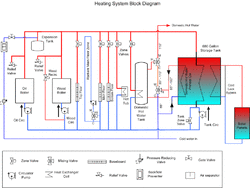O.K, lets say someday when I succeed in adding enough additional baseboard, and low temp. radiators, to qualify my heating system as "low-temp-able", what happens next. Would I heat my storage to 195* and as the storage cools, run it down to my minimum temp say 155*. Or do I install a temperature mixing control valve and set the output to the minimum temperature I want to circulate (155*) all the time?
Temperature control valve.
- Thread starter chuck172
- Start date
-
Active since 1995, Hearth.com is THE place on the internet for free information and advice about wood stoves, pellet stoves and other energy saving equipment.
We strive to provide opinions, articles, discussions and history related to Hearth Products and in a more general sense, energy issues.
We promote the EFFICIENT, RESPONSIBLE, CLEAN and SAFE use of all fuels, whether renewable or fossil.


